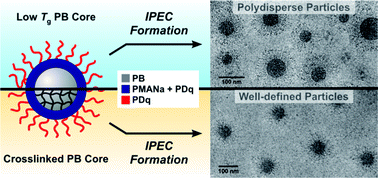Multi-layered micellar interpolyelectrolyte complexes (IPECs) were built up by the complexation of two oppositely charged homo- or block copolymer systems. First, an ampholytic polybutadiene-block-poly(sodium methacrylate)-block-poly{2-[(methacryloyloxy)-ethyl]trimethylammonium methylsulfate} (PB-b-PMANa-b-PDMAEMAq) ABC triblock terpolymer formed stimuli-responsive micelles in a pH 10 aqueous solution with a soft PB core, a PMANa/PDMAEMAq intramicellar IPEC (im-IPEC) shell, and a positively charged PDMAEMAq corona. With the addition of either negatively charged homopolymers (poly(sodium 4-styrenesulfonate) (PSSNa)) or bis-hydrophilic block copolymers comprising a neutral segment (poly(sodium acrylate)-block-poly(N-isopropylacrylamide) (PANa-b-PNIPAAm)), a second IPEC shell was formed. The structure of the resulting complex particles at different ratios of oppositely charged segments was investigated using cryogenic transmission electron microscopy (cryo-TEM) and dynamic light scattering (DLS). We show that the initial terpolymer micelles with the im-IPEC shell exhibit significant dynamic behavior upon further complexation, resulting in changes in core size distribution and aggregation number. We attribute this to the soft core-forming PB block. Upon crosslinking of the PB core such dynamic processes are suppressed, thus more uniform IPEC particles are formed. We further demonstrate that the PNIPAAm corona formed after complexation with PANa-b-PNIPAAm diblock copolymers renders these multicompartment particles thermo-responsive.

You have access to this article
 Please wait while we load your content...
Something went wrong. Try again?
Please wait while we load your content...
Something went wrong. Try again?


 Please wait while we load your content...
Please wait while we load your content...